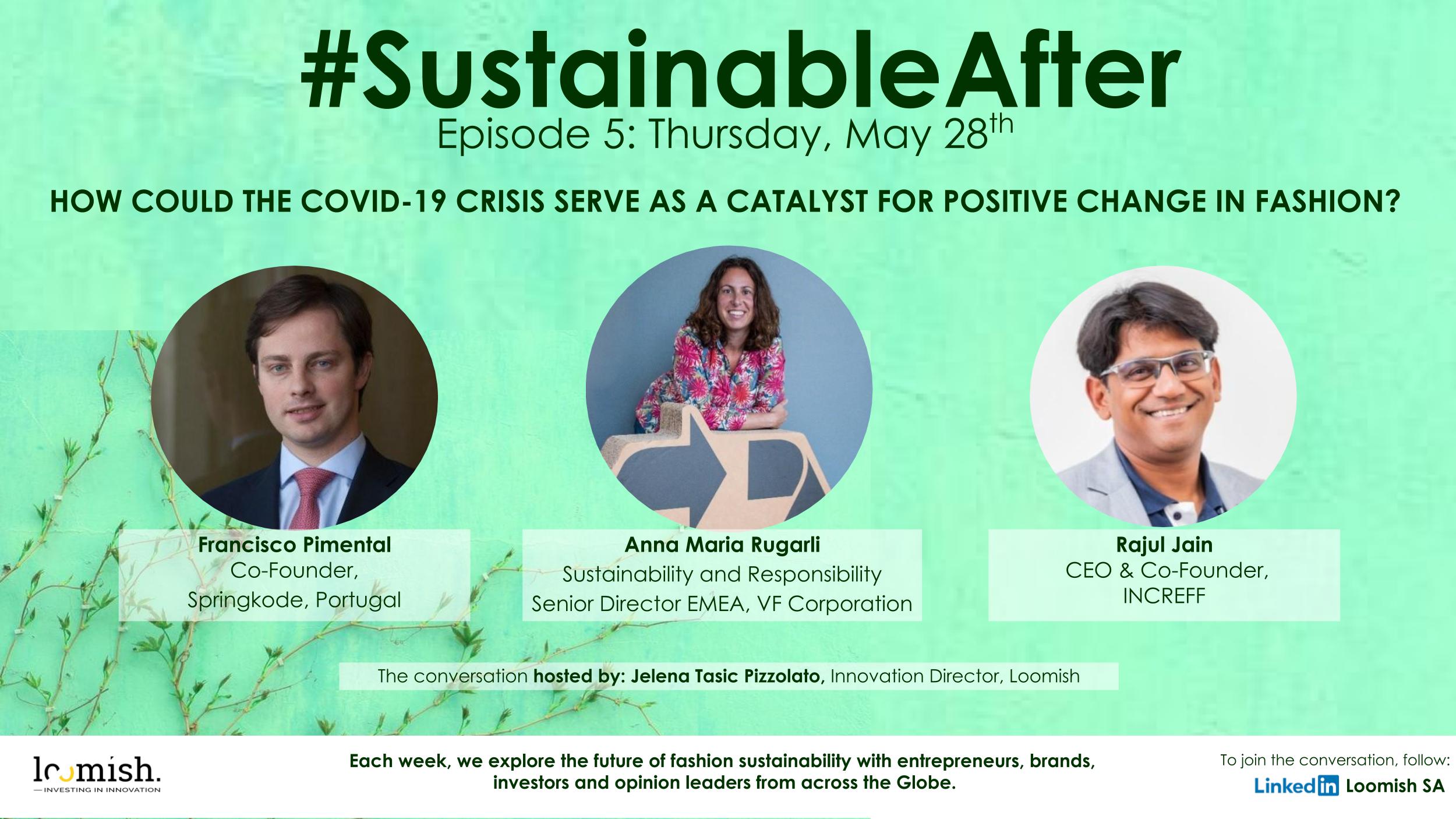#SustainableAfter, Episode 5
Covid19 gave fashion sustainability a dress rehearsal. Now what?
Here’s how fashion brands can get better structured for what comes next
Jelena Tasic Pizzolato, Innovation Director at Loomish in conversation with:
Anna Maria Rugarli, Sustainability and Responsibility Senior Director EMEA, VF Corporation,
Francisco Pimental, Co-founder, Springkode, Portugal,
Rajul Jain, CEO and Co-Founder, INCREFF, India.
—
“Crises tend to accelerate underlying trends,” said Francisco Pimental, co-founder of sustainable marketplace, Springkode and General Manager of MO Fashion, Portugal’s leading fashion brand.
It seems definitely to be the case with sustainability, as the latest think piece from Bain&Company confirms. Maintaining sustainability efforts in a global health crisis is challenging, yet, importantly – the situation has also generated strong tailwinds for sustainability in the long term.
“The pace at which sustainability is gaining importance is speeding up: people are more concerned about themselves, about their health, about respect for the planet,” explained Francisco.
Working against a daunting economic scenario, with the need to simultaneously address the solidifying sustainability trend that is here to stay, many fashion brands are put in a tough position.
In this webinar, we looked at how
- internal organisation,
- multichannel innovation and
- merchandise planning
could help brands get better structured for what comes next.
How internal organisation is essential to successfully drive the sustainability agenda:
best case from VF Corporation
VF Corporation is an American worldwide apparel and footwear company, with over 30 outdoor and activewear brands, including North Face, Timberland and Vans, to name a few. With millions of customers worldwide and thousands of employees, the group’s purpose-led business practices and sustainability focus have been widely appreciated by its customers, employees and stakeholders alike.
 Anna Maria Rugarli, VF’s Senior Sustainability and Responsibility Director EMEA, has been steering the Group’s sustainability agenda for almost a decade now. “VF is a company that is 120 years old, so clearly it was set up at very different times, in a very different way. It needed to change and adapt throughout the times. When you start looking at how to get more sustainable, you need to look at your whole business and what you need to change. And change, obviously, is the challenging part,” she began, explaining how VF set off on its sustainability journey.
Anna Maria Rugarli, VF’s Senior Sustainability and Responsibility Director EMEA, has been steering the Group’s sustainability agenda for almost a decade now. “VF is a company that is 120 years old, so clearly it was set up at very different times, in a very different way. It needed to change and adapt throughout the times. When you start looking at how to get more sustainable, you need to look at your whole business and what you need to change. And change, obviously, is the challenging part,” she began, explaining how VF set off on its sustainability journey.
“We started looking at how, from the corporate perspective, we would make sure that we would build the baseline of sustainability across the whole corporation that would benefit the brands. The way it works at VF is that our brands have four functions that they manage directly, which are product, marketing, sales and retail operations. All the other functions are managed at the corporate, VF level. For instance, indirect procurement or supply chain, which is obviously a huge aspect when it comes to sustainability – these are all managed at the corporate level.”
Why does it matter?
“That means that when we create change at the corporate level, we directly impact all of our brands. We built the baseline across all of the VF functions that would basically build a baseline for the brands that is the same. Then it is up to the brands to decide how much they want to leverage this baseline and how much they want to go and become sustainable.”
VF’s approach also ensures that there is constant incremental improvement in the impact the brands have, as Anna Maria further elaborated:
“From the corporate perspective, year on year, we build the baseline and raise the bar, to make sure that we just don’t deliver on a plan and leave it at that: sustainability is a journey and the idea of sustainability is that there is a constant evolution,” she concluded.
Think about multiple scenarios of multichannel evolution
The ‘traditional’ multichannel roles during this crisis have shifted: while much of physical retail has been shut down across the world, ecommerce has experienced a boom.
According to a new “Global Shopping Index” report published by Salesforce, the number of unique digital shoppers rose 40% year-over-year (YoY).
Next to sustainability, the Covid19 crisis seems to have catalysed the trends of digital transformation for brands and ecommerce uptake for customers as well.
For aeons, brands have been juggling brick-and-mortar stores with ecommerce, mobile, web and social media channels. The commercial weight and customer purpose when using each of these channels has now shifted, so brands are closely looking at the ways of creating the multichannel experience that their customers will want in the post-Covid world.
 Francisco Pimental and his team at MO Fashion are addressing some fundamental questions in that respect:
Francisco Pimental and his team at MO Fashion are addressing some fundamental questions in that respect:
“How do you reinvent the business, especially the role of the store to make sure that it is still central to what the customer will want one or two years down the road? How do we structure ourselves to serve a much bigger digital channel? How to keep the store connected and relevant to the customer?”
Creating products that the customers will want in the new commercial setting does not stop there, but spreads into other frontiers of innovation, as Francisco confirmed:
“How do we address the shift of loungewear to casual clothing trend? How do we increase agility of engaging with new counterparties, such as academia for developing antiviral clothing and other protective textiles?”
In all likelihood, thinking about all these issues now is what is going to set the brands up for future success.
Reducing waste starts with good merchandise planning: predictive analytics in the service of sustainability
Francisco’s start-up Springkode is a sustainable fashion marketplace that connects producers to customers in an Alibaba-like business model, without holding inventory. With a highly eco-conscious customer base, what Springkode sells best are essential quality garments, created through ethical craftsmanship and often with upcycled luxury fabrics.
That assortment is significantly different from what global, highly seasonal fashion businesses are putting in front of their customers each season.
Even with their best sustainability intentions in mind, it is very difficult for big brands to perfectly plan their merchandising and inventory in order to ensure minimal waste at the end of the season.
 Rajul Jain, the CEO and Co-founder of INCREFF (Incredible Efficiency), an Indian scale-up, seems to have found a way, empowered by AI algorithms. As an example, Rajul looks at the types of questions every merchandiser faces at the beginning of the season:
Rajul Jain, the CEO and Co-founder of INCREFF (Incredible Efficiency), an Indian scale-up, seems to have found a way, empowered by AI algorithms. As an example, Rajul looks at the types of questions every merchandiser faces at the beginning of the season:
“What should be the assortment mix, what should be your depth, what should be your size ratios, what inventory should go where, what to replenish, what to replace”, the list goes on.
The fact is that for numerous brands, this kind of planning is still being done using just Excel or tools that were originally made for other industries, such as the automobile or FMCG, which are businesses with very different dynamics than fashion.
INCREFF, however, has created the solution tailored to fashion only, including big amounts of highly granular raw data relevant to fashion: not only about the brand’s retail network or assortment features, but also the purely fashion parameters such as the freshness level, trend, or the novelty of the collection. With their proprietary technology patented both in India and in the US, INCREFF currently works with numerous brands including Puma, GAP, Espirit, Mango, as well as Amazon India.
“Our technology is made in such a way that it will make you produce only what will get sold. It allows merchandisers make very accurate decisions very fast and it automatically predicts what should be your never-out-of-stock style.”
“For brands that work with us, we have been able to reduce inventory by about 20% and we have been able to improve their margins by 4-5%,” ensures Rajul.
Aligning his highly technological business with the sustainability mission, Rajul emphasizes the importance of initial merchandise planning in the overall waste reduction in fashion, adding with what sounds like a perfect slogan for fashion sustainability:
“The more you prevent, the less you need to correct.”
Listen to the full conversation here>>>>>
